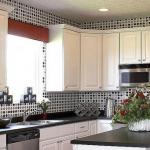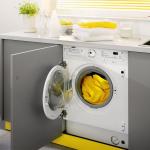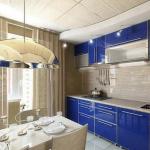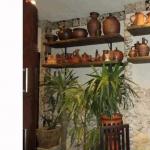How to hang wallpaper in the kitchen so that it doesn’t fall off the next day and looks perfect? The answer is simple - find the phone number of the finishing craftsmen and pay them the required amount of money.
But if you approach the matter responsibly, then all the gluing work can be easily done yourself, saving the family budget, since it does not cause any particular difficulties.
And before you go to the store for wallpaper, adhesive solution and tools, let's look at the main types of wallpaper and the features of gluing them.
Types of Wallpaper
Wallpaper comes in paper, vinyl, non-woven, fiberglass, liquid and even metal. Let's look at the advantages and disadvantages of each type, and also talk about how to beautifully hang wallpaper in the kitchen.



Paper
Paper wallpaper is the most common and inexpensive. They come in smooth and embossed, with one or two layers. Their advantages are low cost (80-150 rubles per roll), environmental friendliness and therefore the ability to use in bedrooms and children's rooms, extreme ease of wall stickers, and a wide range of colors.

Among the disadvantages are: absorption of odors, inability to remove heavy contaminants from the surface without damaging the structure, loss of color from constant exposure to sunlight, short service life - about 5 years, loss of quality when exposed to water.
To glue paper wallpaper, use a special glue, or prepare a paste at home from flour and water. The adhesive solution is applied to the wallpaper, after 10 minutes they are pasted.
The basis of vinyl wallpaper is non-woven or paper, on which foamed vinyl is applied on top. Their surface can be embossed or smooth, sometimes with screen printing. The advantages of such wallpaper include resistance to moisture and, as a result, the ability to remove dirt from it with a damp cloth, color fastness, and elasticity.

With their help, you can hide wall defects; some types can be repainted several times. When purchasing, pay attention to the marking - a square with the number of waves in it. 3 waves is the best indicator, symbolizing maximum resistance to moisture.

The disadvantages of vinyl wallpaper are an obstacle to the penetration of air to the walls, the presence of a specific odor in some rolls (it disappears over time), expansion of the material when wet, which entails certain difficulties when adjusting the seams (not for all types). For gluing vinyl wallpaper, a special glue is used, which can be applied both to them and to the wall.
Non-woven wallpaper
Non-woven wallpaper comes in two types - with and without vinyl coating. The peculiarity of the first ones is that they can be used for painting. Non-woven wallpaper is similar in structure to paper wallpaper, only of higher quality.

Their advantages are greater strength and abrasion resistance in contrast to paper ones, lack of shrinkage and swelling, environmental friendliness, breathability, ease of gluing, and the ability to hide wall defects. Disadvantages: high cost and inability to wash.
For gluing, you can use glue for fiberglass or special glue for this type of wallpaper. It is applied to the wall, after which the fragments are glued.
Fiberglass wallpaper is successfully used in the kitchen. They are made from glass fibers, they are environmentally friendly and durable. Despite this name, they do not prick at all when touched and can be painted.

The advantages of this type of wallpaper are high resistance to wear and, as a result, durability (up to 25 years), the ability to repaint up to 10 times, moisture and fire resistance, and biological resistance.
Among the shortcomings is the meager choice of patterns and colors. To apply wallpaper, use a special dispersed adhesive, which is applied to the walls. It is better to use semi-gloss and glossy latex paints.
Despite the fact that glass wallpaper is used in the kitchen, it has high hygroscopicity (absorbing moisture from the air). Take this into account when choosing.
Liquid wallpaper can be used in the kitchen. Outwardly, they are similar to structural plaster, but they have a difference - some components familiar to it are not used in their production. Wallpaper is sold in powder form; the mixture must be diluted with water in a certain proportion specified by the manufacturer. The price of a package of dry solution is from 350 rubles.

Features of liquid wallpaper:
- No joints, no need to adjust seams;
- Giving the walls an attractive look;
- Hiding wall defects;
- Antistatic;
- Long service life - up to 8 years.
Metal wallpaper
Metallic wallpapers are becoming popular. They consist of several layers - paper, decorative coating with metal foil, dielectric paint, drawing. The wallpaper looks great in a high-tech interior; it has such positive properties as resistance to wear, resistance to sunlight, excellent soundproofing qualities and the ability to be washed. The price for a roll starts from 2 thousand rubles and can reach 12,000-14,000 rubles.

How to glue wallpaper in the kitchen?
Before wallpapering, you need to remove the furniture from the room so that it does not get in the way or get dirty, or move it to the center of the kitchen and cover it with film. It is better to de-energize switches and sockets and remove their housings for a while. To avoid damage to the floor covering, the floor also needs to be covered with some kind of material. The temperature during operation must be maintained at a level from +18 to + 20 degrees.
After the space is freed, you need to prepare the surface of the walls - remove old wallpaper, repair small cracks, sand and prime. The easiest way to remove paper wallpaper is to simply wet it with hot water, spraying it from a spray bottle or applying it with a brush, which is time-consuming and inconvenient. Sometimes they come off easily even without water.

Vinyl or non-woven wallpaper is a little more difficult to remove; for this you can use a steam generator. If peeling off the wallpaper is very difficult, use a metal brush or sandpaper, sand the walls and spray water. After 10 minutes, remove the soaked pieces with a spatula. In some cases, you can use a grinder.
Advice! It is not at all necessary to completely remove the old wallpaper. Pieces that are difficult to remove can be left behind. New wallpaper can also be glued over old ones. They must be paper and adhere well to the wall.
When the wallpaper is removed, you need to fill the cracks, sand the surface of the walls using a block with a sanding mesh, prime it and after 5-6 hours start gluing.
Preparation of adhesive solution
The glue must be moisture-resistant, without lumps, prevent the proliferation of microorganisms, and easily dissolve in water. Each type of wallpaper has its own adhesive, so take this into account when choosing. Its preparation is carried out according to the instructions indicated on the package.
A basin or bucket is used as a container, into which water is first poured, then glue is gradually poured in, immediately stirring it with a stick. When the solution is completely filled, wait 15-20 minutes, mix again and start working.

Roll cutting
If the rolls are without a pattern, cutting them will not cause any difficulties. It is enough to measure the height of the walls and measure out the pieces of the required length. To speed up the process, the wallpaper needs to be rolled out, laying the canvas on the canvas, bending them in the corners. This will require the help of a partner.
If the wallpaper has a pattern, you can do this - stick one strip, then bring the roll to the wall so that the patterns match, make the appropriate marks and cut off the sheets. The disadvantages of gluing wallpaper with a pattern are that more of it is required, since some of the material is wasted when adjusting the patterns.
How to wallpaper a kitchen correctly?
So, the wallpaper is cut into strips of a certain length. Stack them on top of each other so that they are wrong side up. Using a brush or roller, apply glue to the first sheet. Make sure that the layer is not too thick (the wallpaper may tear under the weight of the glue).

Wait 7-10 minutes. Paste the first sheet on the wall, try not to allow any distortions. If necessary, the wall surface can be lined in advance and oriented along vertical stripes.
If the strip is twisted or glued unevenly, peel it off the wall and repeat the gluing procedure. Then carefully smooth the fabric from top to bottom from the center to the edges using a dry cloth or just your hands.
Remains of wallpaper on top and bottom can be carefully removed using a stationery knife or scissors. In the places where switches and sockets are installed, you need to cut holes of a certain size, and then install the housings back. Avoid drafts while working and drying wallpaper.
How to hang wallpaper in the kitchen in an original way?
Finally, a few words about how to hang wallpaper in the kitchen in a non-standard way. To do this, you can combine canvases from different rolls, highlight areas of the room with a certain color, or divide the wall in half.
Photo gallery



![]()







